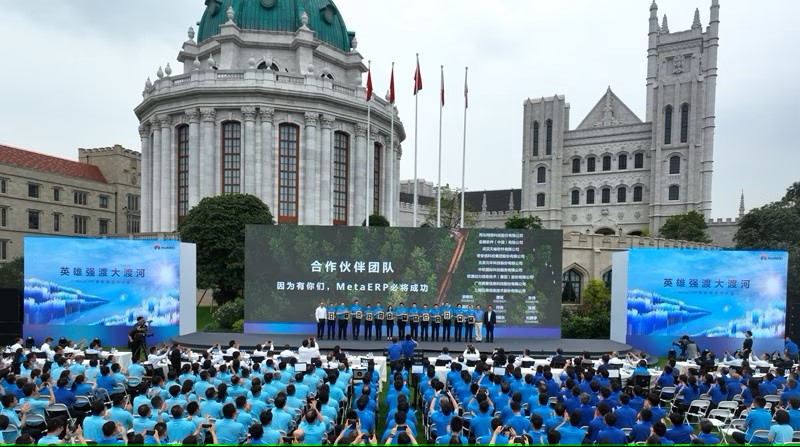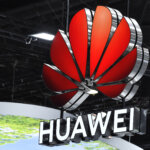
(Source – Huawei)
The challenges of building Huawei’s next-generation MetaERP
Article by Tao Jingwen, Director, President of the Quality, Business Process & IT Management Department, Huawei
- Huawei recently announced that it has replaced a former ERP system with its own MetaERP system over which it has full control.
- In his speech during the launch ceremony, Tao Jingwen, Huawei’s Board Member and President of the Quality, Business Process & IT Mgmt Dept explained the decision and some of the challenges which Huawei encountered in changing ERP systems.
On May 16, 2019, the US added Huawei to the Entity List. Within just a few days, ERP vendors notified Huawei that their supply and services would be suspended. Our 20-year-old ERP system was the core system underpinning Huawei’s enterprise operations and rapid development. It supported Huawei’s efficient billion-dollar business operations across more than 170 countries and regions worldwide. Any issue with the system threatened the “nervous system” of our entire business.

Tao Jingwen, Director, President of the Quality, Business Process & IT Mgmt Dept, Huawei
The sudden cut-off of ERP services was a massive crisis. In response, we systematically reviewed the problems and restrictions of the former system. We decided that in addition to developing our own system with complete, full-stack control, we should also apply new technologies, such as cloud-native architecture, metadata-driven multi-tenant architecture, and real-time intelligence. We decided to build a future-oriented, next-generation core enterprise business system to ensure more secure, efficient operations.
Huawei was heavily reliant on the old ERP system and whilst aware of its weaknesses also recognized its value. We introduced the MRP (Manufacturing Resource Planning) II system back in 1996 and later expanded to the ERP system that supported a host of our diverse global business scenarios. Huawei was one of the largest companies in the world using the ERP system. After exploring many potential solutions, in the end, we realized that the only way out was to develop our own.
MetaERP guarantees our complete, full-stack control. It uses the latest technologies to ensure quick responses to service requirements, scientific and efficient decision-making, as well as secure and reliable application data. In particular, it’s built with:
- Cloud-native architecture makes the most of computing power to support rapid global deployment and automatic adaptation to changes in service traffic, enabling the system to easily cope with service peaks with tens of millions of requests.
- Metadata-driven multi-tenant architecture standardizes metadata assets, such as business objects, entities, and logic, so that tenants can be flexibly orchestrated for quick responses to service requirements.
- Real-time intelligence maximizes the value of data. For example, multiple pre-trained AI models make risk control and decision-making more rational and efficient.
- Huawei’s proprietary GaussDB is able to process up to 30 million accounting entries per day, and completely eliminate the 30-minute delay. Processing is now handled in real-time.
- Backed by our trustworthiness transformation, MetaERP is more secure and controllable and allows efficient use of data while ensuring data security and compliance.
System boundaries had to be redefined, decoupling certain functions to focus on core ERP functionality. The old ERP system was like a massive old building in disrepair. Pipelines and routes were crisscrossed all over the place, and many of them had been built without following preset rules. We implemented the “green field” plan to clean up peripheral business application systems, removing more than 1,000 logical integration points and 3.2 million lines of customized code. Now the business application systems are standardized and plug-and-play. We also decoupled the system based on key business flows to ensure the real-time generation of accounting documents.
New tools had to be developed to support the efficient and reliable system switchover. Our ERP system processed mountains of services and data every day, including 760,000 lines of sales orders, 210,000 lines of AP invoices, and 15 million lines of accounting entries. The system underpinned many complex and critical business scenarios, so ensuring a seamless transition to MetaERP with zero data losses was paramount. It was like changing the engine of a plane mid-flight. We needed to develop a complete set of switching tools to achieve this goal.
For example, we developed ROMA LiveFlow, a patch panel tool. This tool ensures the smooth migration of applications from ERP to MetaERP without impacting normal business operations on peripheral systems. We also developed a data migration tool that was able to migrate and verify 320 billion lines of highly clustered data within 35 hours. We carried out the migration on weekends to minimize the effect on regular business operations.
Our strategic partners included Kingdee, Yonyou, Qi An Xin, Tianyu, Kingsoft, Yonghong, and Yuannian. We developed China’s own components for core enterprise business systems. Through a joint effort, we have produced advanced engineering methods and a rich array of business applications.
Now MetaERP covers 100% of our business scenarios and 80% of our business volume across multiple domains, including sales, services, and manufacturing. MetaERP has already passed the tests for monthly, quarterly, and yearly settlements. While supporting the accuracy and timely release of our annual report, the system ensured zero faults, zero delays, and zero accounting adjustments. Since then, we have not only been able to build our own MetaERP, but also manage the switch and prove its capabilities.
The view in this article is that of the author and does not necessarily represent the view of Tech Wire Asia.
READ MORE
- The criticality of endpoint management in cybersecurity and operations
- Ethical AI: The renewed importance of safeguarding data and customer privacy in Generative AI applications
- How Japan balances AI-driven opportunities with cybersecurity needs
- Deploying SASE: Benchmarking your approach
- Insurance everywhere all at once: the digital transformation of the APAC insurance industry


